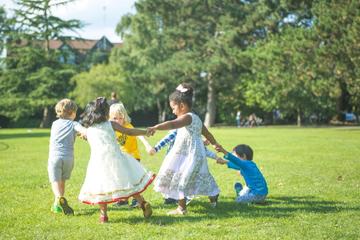Exploring children's right to play through the lens of human rights
Research project based in the United Kingdom and Tanzania
Introducing Dr Naomi Lott
Dr Naomi Lott is a Postdoctoral Research Fellow at the Faculty of Law, currently funded by the John Fell Fund. Naomi's primary research interests are in the field of children's rights, with a particular focus on children's economic, social and cultural rights, and particularly the right to play. Here she talks about her most recent research, funded by the ESRC on the right to play.

What was the issue that you were looking at in this research?
For over thirty years children have had a right to play under the UN Convention on the Rights of the Child but for much of this time little was known about what the right entails, how it should be implemented, and what it means for children. The right to play had been so under explored that it was referred to as a ‘forgotten right’ and the UN Committee on the Rights of the Child (Committee) observed that the right had been ‘neglected’. The lack of engagement with the right and corresponding deficiency of knowledge and understanding of the right has meant that children’s right to play has not been able to be fully implemented.
The nature of play, as something that children will seek to do in most contexts, has contributed to this neglect. It is also likely due to the difficulties of trying to “pin down” what play is, and operationalising the right for a legal context. Further, it has been argued that the right to play was sidelined due to a perception of the right as a ‘luxury.'
What was your argument and how did you make it?
In setting out to research the right to play, I sought to address some of these challenges and to offer a detailed exploration of the right and the measures needed for its implementation. This required moving beyond traditional doctrinal research. I began by exploring literature from a wide range of fields including child biology, education, geography, and psychology to understand the value of play for children and the challenges they face when seeking to enjoy their right to play. I found that whilst children’s play has significant intrinsic and instrumental value – including benefits for their cognitive, social, emotional and physical development and overall wellbeing – children face considerable challenges when looking to enjoy their right. These challenges range from availability and accessibility of appropriate safe spaces for play through to a scholarisation of childhood, a proliferation of excessive use of technology, and market and commercial pressures. Underlying all these challenges is a general lack of understanding of the importance of play for children. Many of these challenges are heightened for adolescent children, or children marginalised for other reasons. Following this analysis of existing literature, I studied records of the drafting process for both the Declaration on the Rights of the Child and the Convention on the Rights of the Child. These showed that treaty drafters saw children’s play as a core aspect of childhood and recognised the value of play for children’s holistic development. Examining the work of the Committee (from 1993-2020) revealed an absence of real engagement with the right both for monitoring purposes and for the purpose of developing normative content of the right, until 2013. In 2013 the Committee produced a General Comment (No.17) on Article 31, which includes the right to play, acknowledging the importance of play for children, and offering some guidance on implementation of Article 31.

To complement this research, I conducted a multiple-case study of the United Kingdom and Tanzania. This case study revealed greater legal protection for the right to play in Tanzania than in the United Kingdom, and an overall support for the right in grass-roots groups across the two nations. However, expert interviews in both countries showed difficulties in realising the right on the ground. My findings echoed many of the challenges expressed in the examined literature, and revealed a need to map the outcomes of play onto other priorities in order to gain traction with government and other key actors such as teachers. For example, through showing the value of play for children’s cognitive development and learning outcomes it may be possible to increase teacher interest in implementing the right to play.
Ultimately, my research found that countering the extensive challenges facing the realisation and enjoyment of children’s right to play requires a societal change that recognises children’s need to play. This should include the development of policies and environments appropriate for children’s play, and a culture shift that perceives play – and especially play in the public space – in a positive light. I shared the findings of this project in The Right of the Child to Play: From Conception to Implementation (Routledge, 2023).
What do you think are / will be the consequences of this research and it's impact?
Following this project, and in view of the considerable benefits of play for children, I held an international symposium at the Bonavero Institute of Human Rights in June of this year, drawing together academics, NGO and I-NGO actors, and other key stakeholders to discuss the right to play and its value for children across a wide range of areas. One key outcome of this will be an edited collection on The Interdependence of the Convention on the Rights of the Child: Understanding the Relationship of the Right to Play with other Convention Rights. This edited collection includes contributions that demonstrate the value of implementing the right to play for realising other children’s rights – such as the rights to education, health, a healthy environment, and their digital rights – and vice versa. Alongside this analysis, others will explore the specific importance of the right to play for children in unique contexts, such as refugee and asylum-seeking children, street children, and disabled children. It is hoped that this collection will further evidence the value of implementing the right to play, and initiate a broader conversation on the interdependence of children’s rights.
One key question that has arisen from my study and conversations with key stakeholders has been how best to implement the right to play for children – what factors are required for implementing the right to play? This question is now the focus of my study, in a project funded by the University of Oxford’s John Fell Fund, ‘Developing a Framework for Implementing the Right to Play’. This study will work with 100 children aged 3-17 across Oxfordshire and Warwickshire, with findings expected to be shared in the autumn of 2024.



